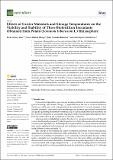Effects of Carrier Materials and Storage Temperatures on the Viability and Stability of Three Biofertilizer Inoculants Obtained from Potato (Solanum tuberosum L.) Rhizosphere

View/
Date
2022-01-20Author
Aloo, Becky
Mbega, Ernest
Makumba, Billy
Tumuhairwe, John
Metadata
Show full item recordAbstract
Biofertilizer technology continues to be derailed by the short shelf life of inoculants. The present study investigated the suitability of wheat-bran (WB), rice-husks (RH), farmyard-manure (FYM), bagasse (BG), and sawdust (SD) in the formulation of potato-derived Klebsiella grimontii (MPUS7), Serratia marcescens (NGAS9), and Citrobacter freundii (LUTT5) under refrigerated (8 °C) and room (25 ± 2 °C) storage. The physicochemical properties of the materials were assessed before sterilization and introduction of the inoculants and assessment of their viability for 8 months. Most of the physicochemical properties of the materials varied significantly (p < 0.05). Bagasse supported the maximum growth of MPUS7 (5.331 log CFU g−1) under refrigeration and LUTT5 (4.094 log CFU g−1) under both conditions. Under room storage, the maximum growth of MPUS7 (3.721 log CFU g−1) occurred in WB. Formulations that remained viable under room storage can easily be integrated into existing agricultural distribution systems that lack refrigeration.
URI
https://doi.org/10.3390/agriculture12020140https://dspace.nm-aist.ac.tz/handle/20.500.12479/1914
